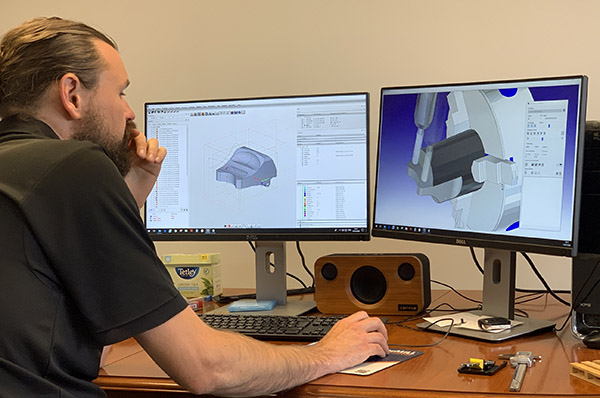
Founded in 1995, Point CNC has provided a high quality and flexible CNC machining service to customers in the medical, aerospace, surveillance and automotive sectors since it opened its doors for business. The evolution of the company down the years has seen the manufacturer invest in high-end machine tools from YMT and CAM software from Open Mind Technologies.
Based in Sevenoaks, Point CNC produces components and sub-assemblies for high-precision surveillance and ANPR camera systems in use by police forces, security agencies and rescue services, as well as high-technology parts for the motorsport and specialist road-car sectors.
With the ever-increasing complexity of components, Point CNC has invested in hyperMILL from Open Mind, a CAM solution for five-axis machining. The ISO9001-accredited subcontract manufacturer has been growing at a rapid rate in recent years, consolidating several facilities by bringing them into one large factory that houses all of the company’s 20 CNC machine tools.
“We are implementing more automation to maximise our output and undertaking more automotive, audio and MoD work at present,” says Joseph Goldsmith, CADCAM programmer at Point CNC.
Referring to the implementation of CAM software from Open Mind Technologies, Goldsmith states: “When I first came here, we were using different software and I had come from a hyperMILL background. The software we had was nowhere near as good as hyperMILL, so I put my case forward to the directors of the business, highlighting that our current growth rate and the turnaround requirements from customers meant we needed to be adopting hyperMILL.”
With a well-made case and business leadership that is always striving to enhance its capabilities, service and performance, the company invested in the hyperMILL CAM system.
“The facility to use things such as the tool library in hyperMILL and to teach our apprentices all the cutting speeds and feeds in a simplified format to build their confidence, has been invaluable,” says Goldsmith. “hyperMILL helps to give the apprentices a good grounding in every-day processes. Additionally, skilled engineers do not have to watch the apprentices all the time, giving our younger employees the responsibility and confidence to evolve.”

Alluding to some of the savings that hyperMILL has generated, Goldsmith says: “Another advantage with the tool library is that it will calculate and optimise all of our speeds and feeds. Once the information has been entered, the speeds and feeds calculated by hyperMILL determine how hard we can be hitting the workpieces. It really has accelerated our programming. By reprogramming existing components in hyperMILL we’ve shaved a lot of time from our processes.”
He adds: “Essentially, we can input tool data from the cutting-tool manufacturer into hyperMILL and it will crunch the numbers and push the machining strategy to its limits. Every time I program hyperMILL I generally think we won’t get away with running at such extremely high speeds and feeds, but we do. It works without fail. On one of the first jobs where I really pushed hyperMILL, it was probably running 20% faster than I would have liked. In fact, it was running so fast there was steam coming off the chips and evaporating out of the machine. It really is helping these machines achieve what they are made to do.”
Referring to how hyperMILL helps to conserve tool life, Goldsmith says: “There are a lot of different factors in play here. For example, the benefits depend upon the type of tooling and what materials you are cutting, but hyperMILL goes a long way to helping with things like that. It creates greater tool engagement, which improves material removal rates, cycle times and tool life.

“Since coming to this company and helping migrate to hyperMILL, cycle times have improved by at least 20% and programming times have improved even further,” continues Goldsmith. “I can program jobs significantly faster as the previous software didn’t have all the facilities and tools I needed to do the job. This is especially the case with 3D work; the previous CAM system just wasn’t capable of doing what we needed.”
From a collision avoidance and security perspective, Goldsmith states: “One of the beautiful things about hyperMILL is that when we are putting all of our models together, we can build up a library of all our machine tools, fixtures, vices, chucks and cutting tools. We can put all of this information into the system and it will give us a 100% accurate picture of what is going to happen before we push the button. This allows us to avoid collisions and highlight things we might have missed.”

With three seats of hyperMILL and a significant investment in CNC machining and turning centres, Goldsmith alludes to the capabilities of hyperMILL with regards to the company’s turning activities, saying: “hyperMILL has had a major impact on our turning operations. Basically, it’s now allowing other people to undertake programming tasks. Before, all the programming for turning was done on CNC consoles on the shop floor. This is very time consuming and, during programming, the machines are not running or making any money. Now that we have hyperMILL we can program all of the turning in the office while the machine is running. After offline programming we just pop the program into the machine, run it through to make sure it works and we’re good to go. This has drastically reduced non-cutting times in the CNC turning department by virtually eliminating on-machine programming.”
Asked if the software is as important as hardware when investing, Goldsmith concludes: “I believe that software is an equally important investment as the hardware. hyperMILL demonstrates this with its significant savings, which are being created both in the programming office and on the shop floor.”
For further information
www.openmind-tech.com














